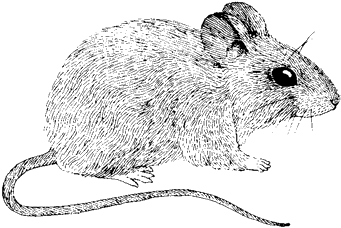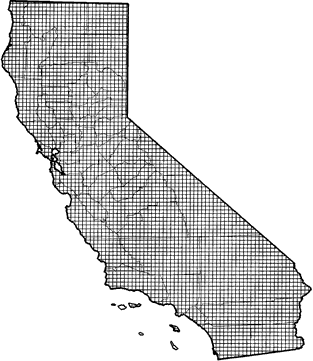
Western Harvest Mouse
Distribution, Abundance, and Seasonality
Distributed throughout California. Common to abundant in shrublands, grasslands, and in early seral stages of most habitats statewide (except at some high elevations).

Range Map
Specific Habitat Requirements
Feeding: Omnivorous. Eats seeds, insects, fruits, and shoots from ground surface, and in bushes (Meserve 1976a). Uses search and consume foraging strategy.
Cover: Prefers thick grass or shrub cover for foraging and nesting. Cover requirements of this active mouse are less than for the secretive R. raviventris, which evolved from it (Fisler 1965).
Reproduction: Nests of woven dried vegetation are constructed in thick grass, at base of shrubs, or amidst debris, litter, or slash. The nest is spherical and about 125 mm (4.9 in) in diameter (Webster and Jones 1982).
Water: Drinks 0.015 cc/gm / body weight/ hr, or 10.4% body weight per day. Capable of extreme urine concentration and can exist on saline water.
Pattern: Ubiquitous, but most abundant in grasslands, shrublands, and early seral stages of forest habitats, usually near water.
Species Life History
Activity Patterns: Nocturnal and crepuscular. Active year-round. Most active on moonless and rainy nights (Pearson 1960).
Seasonal Movements / Migration: None.
Home Range: In California coastal scrub, home range averaged 0.4 to 0.56 ha (1.0 to 1.38 ac) and was as small as 0.14 to 0.2 ha (0.34 to 0.5 ac) (Brant 1962, Meserve 1977). Density fluctuated widely from 2.5 to 123/ha (1-50/ac). In one California population, the maximum distance between captures was 102 m (330 ft) (Fisler 1966).
Territory: The nest is defended. Aggressive behavior highly variable.
Reproduction: Breeds year-round at lower elevations, and late spring to early fall at higher elevations. Reproduction peaks in April, mid-summer, and October (Smith 1936, Fisler 1965, 1971). Litter size averages 2-4 young (range 1-9). In laboratory, females can give birth to 14 litters in a year. Weaning occurs at 24 days (Svihla 1931, Bancroft 1967). Females become sexually mature at 4 mo and are polyestrous.
Niche: This harvest mouse is a small-bodied and long-tailed granivore with grooved upper incisors. Its behavior with conspecifics, and with mice of other species, generally is neutral. Natural predators include snakes, owls, hawks, and predatory mammals, including grasshopper mice. Harvest mice frequently use runways constructed by meadow voles, and there appears to be no tendency to avoid voles in the runways (Pearson 1960).
Sources & References
California Department of Fish and Game, 1999.
California's Wildlife, Sacramento, CA.
Written by: P. Brylski, reviewed by: H. Shellhammer, edited by: R. Duke
Bancroft, W. L. 1967. Record fecundity for Reithrodontomys megalotis. J. Mammal. 48:306-308. Brant, D. H. 1962. Measures of the movements and population densities of small rodents. Univ. Calif. Publ. Zool. 62:105-184. Fisler, G. F. 1965. Adaption and speciation in harvest mice of the marshes of San Francisco Bay. Univ. Calif. Publ. Zool. 77:1-108. Fisler, G. F. 1966. Homing in the western harvest mouse, Reithrodontomys megalotis. J. Mammal. 47:53-58. Fisler, G. F. 1971. Age structure and sex ratio in populations of Reithrodontomys. J. Mammal. 52:653-662. Hall, E. R. 1946. Mammals of Nevada. Univ. California Press, Berkeley. 710pp. Meserve, P. L. 1976a. Habitat and resource utilization by rodents of a California coastal sage scrub community. J. Anim. Ecol. 45:647-666. Meserve, P. L. 1976b. Food relationships of a rodent fauna in a California coastal sage scrub community. J. Mammal. 57:300-319. Meserve, P. L. 1977. Three-dimensional home ranges of cricetid rodents. J. Mammal. 58:549-558. Pearson, O. P. 1960. Habits of harvest mice revealed by automatic photographic recorders. J. Mammal. 41:58-74. Smith, C. F. 1936. Notes on the habits of the long-tailed harvest mouse. J. Mammal. 17:274-278. Svihla, R. D. 1931. Notes on desert and dusky harvest mice (Reithrodontomys m. megalotis and R. m. nigrescens). J. Mammal. 12:363-365. Webster, W. D., and J. K. Jones, Jr. 1982. Reithrodontomys megalotis. Mammal. Species No. 167. 5pp. Williams, D. F. 1986. Mammalian species of special concern in California. Calif. Dept. Fish and Game, Sacramento. Admin. Rep. 86-1. 112pp.
California Animal Facts | California's Wildlife